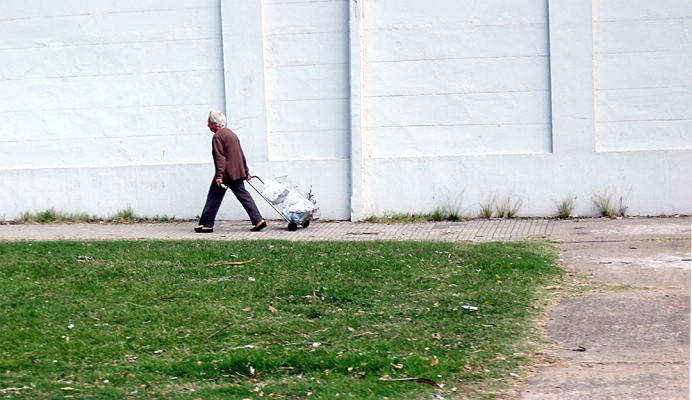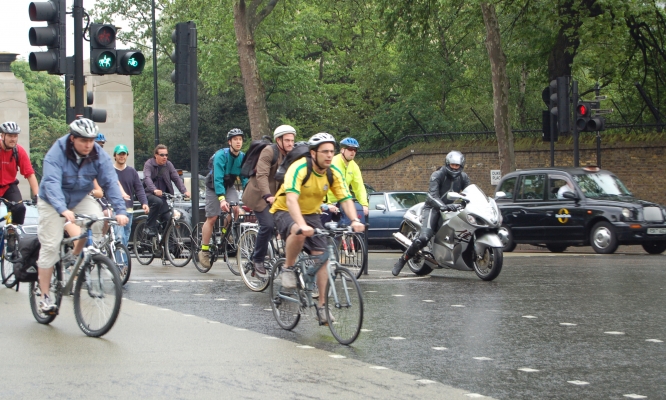Watch video
By Jennifer Dill, TREC director.
I recently completed a national poll of people living in urban areas in conjunction with the National Association of Realtors® on Community and Transportation Preferences. The overall results are posted here. The survey included 3,000 adults living in the 50 largest urban areas in the U.S. (That includes suburban areas, as well as denser urban cores.) Here are some highlights related to bicycling.
1. Less than one in five people have biked in the past month.
Overall, 72% of the adults surveyed said they were physically able and know how to ride a bike. Of those, 25% had ridden in the past month. (The survey was conducted in mid-May, so weather was reasonable.) That means only about 18% of adults in these urban areas biked recently. Most of the people who had biked, rode only for exercise (60%, or 15% of those who are able to bike), while the others (40%, or 10% of those who are able to bike) made at least some bike trips for transportation, such as to work, school, shopping, etc.
Note: From here on I will be focusing only on those people who are physically able and know how to ride a bike.
2. There are gender and generational gaps.
This isn’t a big surprise, but women were less likely to bike than men,...
Read moreWatch video
View slides
The overall goal of this research was to quantify the safety performance of alternative traffic control strategies to mitigate right-turning-vehicle/bicycle collisions, often called "right-hook" crashes, at signalized intersections in Oregon.
A two stage experiment was developed in the OSU high-fidelity driving simulator to investigate the causal factors of right-hook crashes at signalized intersections with a striped bike lane and no right-turn lane, and to then identify and evaluate alternative design treatments that could mitigate the occurrence of right-hook crashes.
Experiment 1 investigated motorist and environmental related causal factors of right-hook crashes, using three different motorist performance measures:
- visual attention,
- situational awareness (SA) and
- crash avoidance behavior.
Data was collected from 51 participants (30 male and 21 female) turning right 820 times in 21 different experimental scenarios. It was determined that the worst case right-hook scenario occurred when a bicycle was approaching the intersection at a higher speed (16 mph) and positioned in the blind zone of the motorist. In crash and near crash situations (measured by time-to-collision) the most common cause was a...
Read moreThe video begins at 1:37.
View slides
Summary: Signalized intersections often rely on vehicle detection to determine when to give a green light. The 2009 Manual of Uniform Traffic Control Devices (MUTCD) includes an on-pavement marking and curbside sign that public agencies can use to indicate where cyclists should position themselves while waiting at an intersection. This presentation reviews the effectiveness of current markings, signs, and other methods used to help cyclists properly position themselves over detection.
Stefan Bussey is an undergraduate civil engineering student at Portland State University. He is interested in exploring how road users’ interactions with each other and the built environment affect the efficiency and safety of road networks. He currently works as a civil design intern at Harper Houf Peterson Righellis Inc.
The video begins at 2:58.
Abstract: While TriMet and other transit agencies serve many commuters by having racks for bikes on trains and buses, large bike parking facilities in global capitals of urban bicycling provide the key link between bikes and transit. Following the lead of European and Asian cities, the Portland region is starting to develop a network of bike-transit facilities; TriMet is piloting smart bike parking technology in the form of electronic bike lockers and "Bike & Rides". This presentation discusses the background and planning for bike-transit integration in the region and shares insights into bike-transit travel patterns, habits, and market segmentation gained from recent rider surveys.
View the presentation slides here.
This project builds on the success of NITC’s first Pooled Fund project that created the first national...
Read moreThe video begins at 0:34.
View slides
Speaker: Joseph Broach, Ph.D. Candidate, Portland State University
Topic: Trick or Treatment? Impact of Route-Level Features on Decisions to Walk or Bike
Summary: Some travel routes attract people walking and cycling, while others may scare them away. What features of street environments are most important, and how do available routes affect decisions to bike or walk on a specific trip?
Research to date has focused on either large-scale areal measures like "miles of bike lane nearby" or else has considered only shortest path routes. Neither method is suited to capturing the impact of targeted route-level policies like neighborhood greenways. This session will present a new technique for measuring bike and walk accessibility along the most likely route for a given trip. The method is applied to travel data, and results provide new insight into the relationship between route quality and travel mode choice.
View slides
Watch video:
Some researchers have tried to categorize cyclists’ levels of traffic stress utilizing facility or traffic data that can be readily measured in the field, such as motorized travel lanes, travel speeds, and type of bicycle infrastructure.
This seminar will present data and modeling results utilizing two novel data sources:
(a) real-world, on-road measurements of physiological stress as cyclists...
Read more

